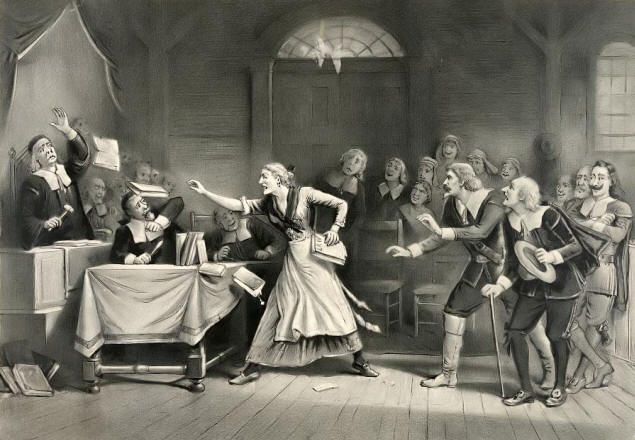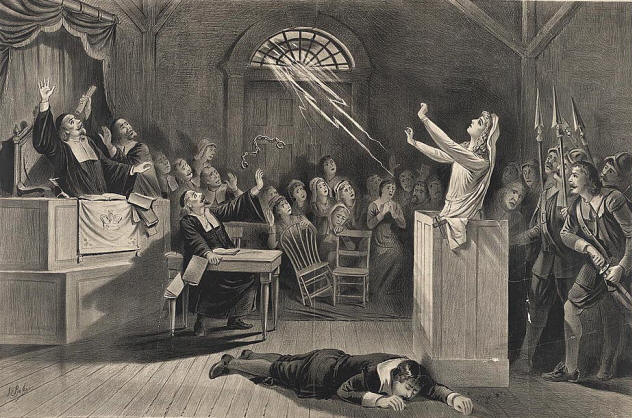Salem Witch Trials
|
|
This Site:
|
Witchcraft, SALEM. The terrible delusion of belief in witchcraft accompanied the New England settlers, and they adopted English laws against it. For a long time it was simply an undemonstrative belief, but at length it assumed an active feature in society in Massachusetts, as it was encouraged by some of the clergy, whose influence was almost omnipotent. Before 1688 four persons accused of witchcraft had suffered death in the vicinity of Boston. The first was Margaret Jones, of Charlestown, hanged in 1648. In 1656, Ann Hibbens, sister of Governor Bellingham, of Massachusetts, was accused of being a witch, tried by a jury, and found guilty. The magistrates refused to accept the verdict, and the case was carried to the General Court, where a majority of that body declared her guilty, and she was hanged. In 1688 a young girl in Danvers (a part of Salem) accused a maidservant of theft. The servant's mother, a "wild Irishwoman" and a Roman Catholic, declared with vehemence that the charge was false, whereupon the accuser, out of revenge, accused the Irishwoman of having bewitched her. Some of the girl's family joined in the accusation and assisted her in her operations. They would alternately become deaf, dumb, and blind; bark like dogs and purr like cats: but none of them lost their appetite or needed sleep. Rev. Cotton Mather - a superstitious, credulous, and egotistical clergyman; a firm believer in witchcraft, and who believed America was originally peopled with " a crew of witches transported hither by the devil "-hastened to Danvers, with other clergymen as superstitious as himself, spending a whole day there in fasting and prayer, and so controlled the devil, he said, who would allow the poor victims to "read Quaker books, the Common Prayer, and popish books," but not the Bible. Mather and his associates were satisfied that the Irishwoman was a witch, and these holy men had the satisfaction of seeing the poor creature hanged. The excited Mather (who was ridiculed by unbelievers) preached a sermon against witchcraft, crying from the pulpit, with arms extended, " Witchcraft is the most nefarious high-treason against the Majesty on high. A witch is not to be endured in heaven or on earth." His sermon was printed and scattered broadcast among the people, and bore terrible fruit not long afterwards. In 1692 an epidemic disease broke out in Danvers resembling epilepsy. The physicians could not control it, and, with Mather's sermon before them, they readily ascribed it to witchcraft. A niece and daughter of the parish clergyman were seized with convulsions and swelling of the throat, and all the symptoms produced by hysterics. Their strange actions frightened other young girls. A belief that evil spirits in the form of witches were permitted to afflict the people was soon widespread, and terror took possession of their minds, and held it for about six months. The "victims" pretended to see their tormentors with their "inner vision," and forthwith they would accuse some old or ill-favored woman of bewitching them. At length the "afflicted" and the accused became so numerous that no person was safe from suspicion and its consequences. During the prevalence of this terrible delusion, in the spring and summer of 1692, nineteen persons were hanged; one was killed by the horrible punishment of pressing to death; fifty-five were frightened or tortured into a confession of guilt; 150 were imprisoned, and fully 200 were named as worthy of arrest. Among those hanged was Rev. Mr. Burroughs, an exemplary clergyman, whose purity of character was conspicuous. Malice, rapacity, and revenge often impelled persons to accuse others who were innocent; and when some statement of the accused would move the court and audience in favor of the prisoner, the accuser would solemnly declare that he saw the devil standing beside his victim whispering his touching words in his or her ear. And the absurd statement would be believed by the judges on the bench. Some, terrified, and with the hope of saving their lives or avoiding the horrors of imprisonment, would falsely accuse their friends and kinsfolk; while others, moved by the same instinct and hopes, would falsely confess themselves witches. Neither age, sex, nor condition was spared. Finally Sir William Phipps (the governor of Massachusetts, who had instituted the court for the trial of witches), his lieutenant, some near relatives of Cotton Mather, and learned and distinguished men who had promoted the delusion by acquiescing in the proceedings against accused persons, became objects of suspicion. The governor's wife, Lady Phipps, one of the purest and best of women was accused of being a witch. The sons of ex-Governor Bradstreet were compelled to flee to avoid the perils of false accusations; near relatives of Mather were imprisoned on similar charges. When the magnates in Church and State found themselves in danger they suspected they had been acting unrighteously towards others, and cautiously expressed doubts of the policy of further proceedings against accused persons, for they remembered that they had caused a constable who had arrested many, and refused to arrest any more, to be hanged. A citizen of Andover who was accused, wiser and bolder than the magistrates and clergy, caused the arrest of his accuser on a charge of defamation of character, and laid his damages at £1,000. The public mind was in sympathy with him. The spell was instantly broken, and at a convention of clergymen they declared it was not inconsistent with Scripture to believe that the devil might " assume the shape of a good man, and that so he may have deceived the afflicted." Satan, as usual, was made the scapegoat for the sins and follies of magistrates, clergy, and people. Many of the accusers came forward and published solemn recantations or denials of the truth of their testimony, which had been given, they said, to save their lives. The legislature of Massachusetts appointed a general fast and supplication, " that God would pardon all the errors of his servants and people in a late tragedy raised among them by Satan and his instruments," and Judge Sewall, who had presided at many trials in Salem, stood up in his place in the church on that fast-day and implored the prayers of the people that the errors which he had committed " might not be visited by the judgments of an avenging God on his country, his family, and himself." The parish minister at Danvers in whose family the "affliction" started, and who was zealous in promoting the prosecutions, was compelled to leave the country. The credulous Mather still believed in witches, and wrote in support of the belief. He was thoroughly ridiculed by unbelievers, one of whom he dismissed by calling him " a coal from hell," and suing him for slander. This episode in the history of Massachusetts is known as " Salem Witchcraft." It astonished the civilized world, and made an unfavorable impression on the surrounding Indians. The Jesuit missionaries took advantage of it to contrast their own mild religious system with the cruel exhibitions of that of the Puritans, whose ministers had been so prominent in the fearful tragedy.
|
|
|
||
|
|
Site Copyright 2003-2018 Son of the South. For Questions or comments about this collection, contact: paul@sonofthesouth.net |
|
|
Are you Scared and Confused? Read My Snake Story, a story of hope and encouragement, to help you face your fears. |
||

